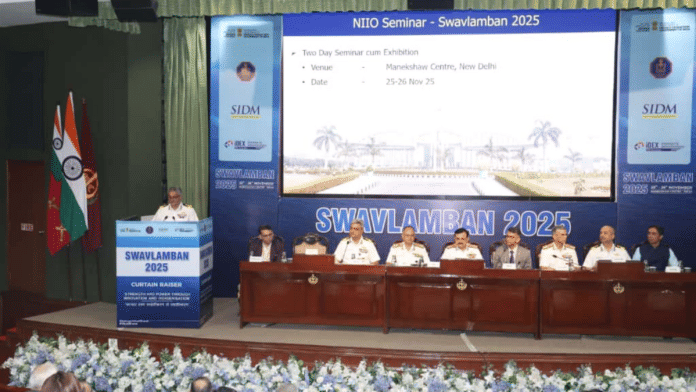New Delhi: Noting that India cannot afford to stay behind the technology curve when it comes to war-fighting, Vice Chief of the Naval Staff (VCNS), Vice-Admiral Sanjay Vatsayan, said Friday that the Navy will come up with a fresh set of challenge statements for the industry to solve.
“The Navy is exploring all possible use-cases in emerging technologies so that we don’t fall behind…We have always been behind the technology curve, but our plan is to catch up to the curve that the world is operating at,” he said, while addressing the media.
The VCNS announced ‘Swavlamban 2025’, the Navy’s seminar on innovation and indigenisation, which will be held on 25-26 November at the Manekshaw Centre in New Delhi.
Responding to questions, the vice-admiral stressed the urgent need to close gaps in niche technologies, including unmanned systems, counter-unmanned systems, unmanned underwater systems, space technologies, high-performance computing and quantum computing—areas where China has made rapid advances.
He said the Navy has ramped up its innovation outreach. Since 2022 it has launched more than 75 challenges, increasing its share of iDEX (Innovation for Defence Excellence) challenges to over 35 percent of the tri-service total since iDEX began in 2018.
To date, these efforts have amounted to some 198 challenges, for which the Defence Innovation Organisation (DIO) has committed over Rs 2,000 crore, of which Rs 450 crore has already been disbursed, he said. He added: “… Of the 198, not all have been accorded AoNs (Acceptance of Necessities) as a lot of these niche technologies are at varying TDLs (Technology Readiness Levels) and might take a few years to develop.”
The flagship event will showcase technologies and solutions that have won contracts and are deployed at various levels, including on the aircraft carriers INS Vikrant and INS Vikramaditya.
A highlight of the 2024 edition was the launch of Matangi, an indigenous autonomous surface vehicle (ASV) that completed a roughly 1,500-km voyage from Mumbai to Thoothukudi as part of the “Sagarmala Parikrama” initiative. The Navy has ordered for 12 such vessels.
Also Read: Indian Navy modernisation riddled with binaries. Maritime strategy is directionless
Pipeline of new vessels
The Vice Admiral said the Navy expects to commission four ships before the end of this year, about 19 vessels next year, and some 13–14 ships in 2027.
He added that 69 ships and six submarines have received initial approvals from the Ministry of Defence (MoD); the Navy expects to issue formal contracts for these programmes over the next year, with the combined value likely to exceed Rs 2 lakh crore.
On next-generation destroyers, the VCNS said he hopes to secure an initial nod from the MoD in the current fiscal year.
Tejas Bhatotia is an alum of ThePrint School of Journalism, currently interning with ThePrint
(Edited by Shashank Kishan)
Also Read: Chinese submarines, frigates are modernising Pakistan Navy. India must keep pace






